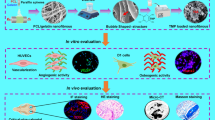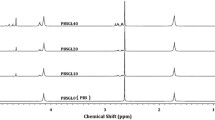Abstract
Background:
Guided bone regeneration (GBR) is commonly used to regenerate periodontal tissue. However, the bone inductivity and antibacterial properties of the GBR membranes currently in use are severely limited. This issue can be resolved by loading growth factors and antibiotics. Bioactive substitutes, such as Au nanoparticles (AuNPs) and carbon quantum dots (CDs), were proposed to prevent the denaturation of osteogenic growth factors and the induction of antibacterial drug resistance.
Methods:
Ornidazole was initially used as the raw material to prepare the CDs, followed by the incorporation of an optimal ratio of nanoparticles to produce the electrospun membrane doped with AuNPs and novel traceable antibacterial CDs. The morphology of the membrane was characterized. The adhesion, proliferation, and osteogenic differentiation of cells on the membrane were evaluated in vitro. The antimicrobial characteristics of the membrane were also investigated. The electrospun membrane was implanted into a rat skull defect model in vivo to investigate its osteogenic potential.
Results:
The blending of nanomaterials did not affect the micro morphology of the fiber, resulting in enhanced mechanical properties. Membranes doped with AuNPs and CDs exhibited excellent biocompatibility, increased ALP activity, improved calcified nodules, and increased expression of osteogenic-associated proteins, in addition to pronounced antibacterial effects. The membrane also demonstrated excellent osteogenic characteristics in rat models.
Conclusion:
The synergistic effect of loaded AuNPs electrospun fiber membrane with CDs can promote periodontal bone regeneration and exert antibacterial activity.







Similar content being viewed by others
Data availability statement
The data presented in this study are available on request from all the authors.
References
Dentino A, Lee S, Mailhot J, Hefti AF. Principles of periodontology. Periodontol. 2000;61:16–53.
Araujo LL, Lourenço TGB, Colombo A. Periodontal disease severity is associated to pathogenic consortia comprising putative and candidate periodontal pathogens. J Appl Oral Sci. 2023;31: e20220359.
Daghrery A, Ferreira JA, Xu J, Golafshan N, Kaigler D, Bhaduri SB, et al. Tissue-specific melt electrowritten polymeric scaffolds for coordinated regeneration of soft and hard periodontal tissues. Bioact Mater. 2022;19:268–81.
Seong YJ, Song EH, Park C, Lee H, Kang IG, Kim HE, et al. Porous calcium phosphate-collagen composite microspheres for effective growth factor delivery and bone tissue regeneration. Mat Sci Eng C Mater Biol Appl. 2020;109:110480.
Lee J, Lee S, Ahmad T, Madhurakkat Perikamana SK, Lee J, Kim EM, et al. Human adipose-derived stem cell spheroids incorporating platelet-derived growth factor (PDGF) and bio-minerals for vascularized bone tissue engineering. Biomaterials. 2020;255:120192.
Zhang Y, Kong N, Zhang Y, Yang W, Yan F. Size-dependent effects of gold nanoparticles on osteogenic differentiation of human periodontal ligament progenitor cells. Theranostics. 2017;7:1214–24.
Zheng K, Sui B, Ilyas K, Boccaccini AR. Porous bioactive glass micro- and nanospheres with controlled morphology: developments, properties and emerging biomedical applications. Mater Horiz. 2021;8:300–35.
Bennur T, Javdekar V, Tomar GB, Zinjarde S. Gold nanoparticles biosynthesized by nocardiopsis dassonvillei NCIM 5124 enhance osteogenesis in gingival mesenchymal stem cells. Appl Microbiol Biotechnol. 2020;104:4081–92.
Niu C, Yuan K, Ma R, Gao L, Jiang W, Hu X, et al. Gold nanoparticles promote osteogenic differentiation of human periodontal ligament stem cells via the p38 MAPK signaling pathway. Mol Med Rep. 2017;16:4879–86.
Sul OJ, Kim JC, Kyung TW, Kim HJ, Kim YY, Kim SH, et al. Gold nanoparticles inhibited the receptor activator of nuclear factor-κb ligand (RANKL)-induced osteoclast formation by acting as an antioxidant. Biosci Biotechnol Biochem. 2010;74:2209–13.
How KY, Song KP, Chan KG. Porphyromonas gingivalis: an overview of periodontopathic pathogen below the gum line. Front Microbiol. 2016;7:53.
Jin Y, Yang Y, Duan W, Qu X, Wu J. Synergistic and on-demand release of Ag-AMPs loaded on porous silicon nanocarriers for antibacteria and wound healing. Acs Appl Mater Interfaces. 2021;13:16127–41.
Loo CY, Rohanizadeh R, Young PM, Traini D, Cavaliere R, Whitchurch CB, et al. Combination of silver nanoparticles and curcumin nanoparticles for enhanced anti-biofilm activities. J Agric Food Chem. 2016;64:2513–22.
Nguyen TK, Lam SJ, Ho KK, Kumar N, Qiao GG, Egan S, et al. Rational design of single-chain polymeric nanoparticles that kill planktonic and biofilm bacteria. Acs Infect Dis. 2017;3:237–48.
Tabaraki R, Nazari F. Comparison of carbon dots prepared in deep eutectic solvent and water/deep eutectic solvent: study of fluorescent detection of Fe3+ and cetirizine and their photocatalytic antibacterial activity. J Fluoresc. 2022;32:549–58.
Shaikh AF, Tamboli MS, Patil RH, Bhan A, Ambekar JD, Kale BB. Bioinspired carbon quantum dots: an antibiofilm agents. J Nanosci Nanotechnol. 2019;19:2339–45.
Otis G, Bhattacharya S, Malka O, Kolusheva S, Bolel P, Porgador A, et al. Selective labeling and growth inhibition of pseudomonas aeruginosa by aminoguanidine carbon dots. Acs Infect Dis. 2019;5:292–302.
Qian Z, Ma J, Shan X, Feng H, Shao L, Chen J. Highly luminescent N-doped carbon quantum dots as an effective multifunctional fluorescence sensing platform. Chemistry. 2014;20:2254–63.
Liang G, Shi H, Qi Y, Li J, Jing A, Liu Q, et al. Specific anti-biofilm activity of carbon quantum dots by destroying p. gingivalis biofilm related genes. Int J Nanomedicine. 2020;15:5473–89.
Guo L, Li L, Liu M, Wan Q, Tian J, Huang Q, et al. Bottom-Up Preparation of nitrogen doped carbon quantum dots with green emission under microwave-assisted hydrothermal treatment and their biological imaging. Mat Sci Eng C Mater Biol Appl. 2018;84:60–6.
Liu J, Lu S, Tang Q, Zhang K, Yu W, Sun H, et al. One-step hydrothermal synthesis of photoluminescent carbon nanodots with selective antibacterial activity against porphyromonas gingivalis. Nanoscale. 2017;9:7135–42.
Li Y, Jin D, Fan Y, Zhang K, Yang T, Zou C, et al. Preparation and performance of random- and oriented-fiber membranes with core-shell structures via coaxial electrospinning. Front Bioeng Biotechnol. 2023;10:1114034.
Parham S, Kharazi AZ, Bakhsheshi-Rad HR, Ghayour H, Ismail AF, Nur H, et al. Electrospun nano-fibers for biomedical and tissue engineering applications: a comprehensive review. Materials. 2020;13:2153.
Chen Y, Xu W, Shafiq M, Song D, Wang T, Yuan Z, et al. Injectable nanofiber microspheres modified with metal phenolic networks for effective osteoarthritis treatment. Acta Biomater. 2023;157:593–608.
Malikmammadov E, Tanir TE, Kiziltay A, Hasirci V, Hasirci N. PCL and PCL-based materials in biomedical applications. J Biomater Sci Polym Ed. 2018;29:863–93.
Qian Y, Zhou X, Zhang F, Diekwisch TGH, Luan X, Yang J. Triple PLGA/PCL scaffold modification including silver impregnation, collagen coating, and electrospinning significantly improve biocompatibility, antimicrobial, and osteogenic properties for orofacial tissue regeneration. Acs Appl Mater Interfaces. 2019;11:37381–96.
Zhao L, Jiang D, Cai Y, Ji X, Xie R, Yang W. Tuning the size of gold nanoparticles in the citrate reduction by chloride ions. Nanoscale. 2012;4:5071–6.
Hill SA, Benito-Alifonso D, Davis SA, Morgan DJ, Berry M, Galan MC. Practical three-minute synthesis of acid-coated fluorescent carbon dots with tuneable core structure. Sci Rep. 2018;8:12234.
Qian Y, Zhou X, Sun H, Yang J, Chen Y, Li C, et al. Biomimetic domain-active electrospun scaffolds facilitating bone regeneration synergistically with antibacterial efficacy for bone defects. Acs Appl Mater Interfaces. 2018;10:3248–59.
Peng W, Ren S, Zhang Y, Fan R, Zhou Y, Li L, et al. MgO nanoparticles-incorporated PCL/gelatin-derived coaxial electrospinning nanocellulose membranes for periodontal tissue regeneration. Front Bioeng Biotechnol. 2021;9: 668428.
Lin NH, Menicanin D, Mrozik K, Gronthos S, Bartold PM. Putative stem cells in regenerating human periodontium. J Periodontal Res. 2008;43:514–23.
Leem YH, Lee KS, Kim JH, Seok HK, Chang JS, Lee DH. Magnesium ions facilitate integrin alpha 2- and alpha 3-mediated proliferation and enhance alkaline phosphatase expression and activity in hBMSCs. J Tissue Eng Regen Med. 2016;10:E527–36.
Ren S, Zhou Y, Zheng K, Xu X, Yang J, Wang X, et al. Cerium oxide nanoparticles loaded nanofibrous membranes promote bone regeneration for periodontal tissue engineering. Bioact Mater. 2021;7:242–53.
Xia Y, Fan X, Yang H, Li L, He C, Cheng C, et al. ZnO/nanocarbons-modified fibrous scaffolds for stem cell-based osteogenic differentiation. Small. 2020;16:e2003010.
Gong M, Huang C, Huang Y, Li G, Chi C, Ye J, et al. Core-sheath micro/nano fiber membrane with antibacterial and osteogenic dual functions as biomimetic artificial periosteum for bone regeneration applications. Nanomedicine. 2019;17:124–36.
Xu Z, Xu Y, Basuthakur P, Patra CR, Ramakrishna S, Liu Y, et al. Fibro-porous plla/gelatin composite membrane doped with cerium oxide nanoparticles as bioactive scaffolds for future angiogenesis. J Mater Chem B 2020. https://doi.org/10.1039/d0tb01715a
Acknowledgements
This work was supported by a grant from the National Natural Science Foundation of China (NSFC, no. 81972536), the Key Project of Health Commission of Jiangsu Province (no. K2019013), the Natural Science Foundation of Jiangsu Higher Education Institutions of China (no. 20KJA320003), A Project Funded by the Priority Academic Program Development of Jiangsu Higher Education Institutions (PAPD, 2018-87), and Postgraduate Research & Practice Innovation Program of Jiangsu Province (KYCX20_1409).
Author information
Authors and Affiliations
Corresponding author
Ethics declarations
Conflict of interest
The authors declare no potential conflicts of interest.
Ethical statement
The study was approved by the Ethics Committee of Nanjing Medical University (PJ2021-145–001). The animal experiment was approved by the Institutional Animal Care and Use Committee of Nanjing Medical University (IACUC approval No. 2012010).
Additional information
Publisher's Note
Springer Nature remains neutral with regard to jurisdictional claims in published maps and institutional affiliations.
Supplementary Information
Below is the link to the electronic supplementary material.
Rights and permissions
Springer Nature or its licensor (e.g. a society or other partner) holds exclusive rights to this article under a publishing agreement with the author(s) or other rightsholder(s); author self-archiving of the accepted manuscript version of this article is solely governed by the terms of such publishing agreement and applicable law.
About this article
Cite this article
Wang, J., Zhang, H., Wang, Y. et al. AuNP-Loaded Electrospinning Membrane Cooperated with CDs for Periodontal Tissue Engineering. Tissue Eng Regen Med 20, 1091–1108 (2023). https://doi.org/10.1007/s13770-023-00583-4
Received:
Revised:
Accepted:
Published:
Issue Date:
DOI: https://doi.org/10.1007/s13770-023-00583-4




